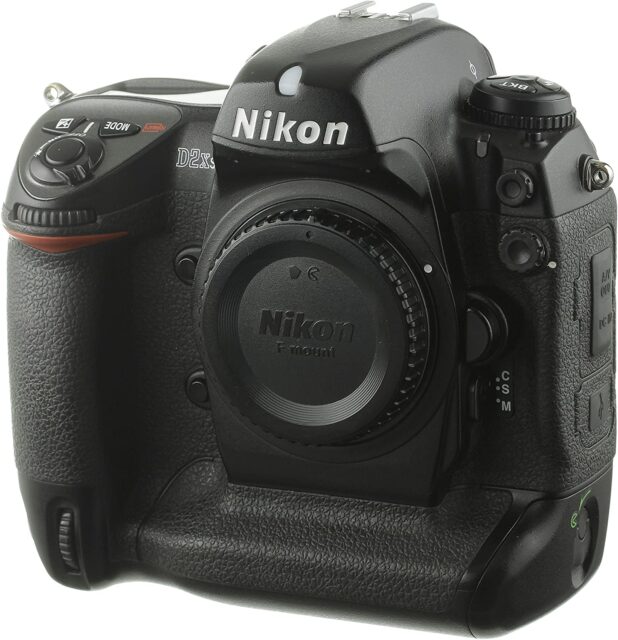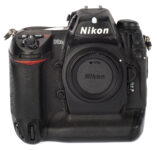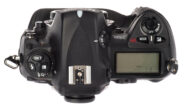Announced
Production status
System
Nikon F APS-C system cameras
- Nikon D1
- Nikon D100
- Nikon D1H
- Nikon D1X
- Nikon D200
- Nikon D2H
- Nikon D2Hs
- Nikon D2X
- Nikon D2Xs
- Nikon D300
- Nikon D3000
- Nikon D300s
- Nikon D3100
- Nikon D3200
- Nikon D3300
- Nikon D3400
- Nikon D3500
- Nikon D40
- Nikon D40X
- Nikon D50
- Nikon D500
- Nikon D5000
- Nikon D5100
- Nikon D5200
- Nikon D5300
- Nikon D5500
- Nikon D5600
- Nikon D60
- Nikon D70
- Nikon D7000
- Nikon D70s
- Nikon D7100
- Nikon D7200
- Nikon D7500
- Nikon D80
- Nikon D90
Nikon D2Xs
APS-C AF digital SLR camera • Discontinued
Specification
| Format: | |
| APS-C | |
Imaging sensor: | 23.7 × 15.7mm CMOS sensor |
Resolution: | 4288 × 2848 - 12 MP |
Crop factor: | 1.52x |
Sensor-shift image stabilization: | - |
| Nikon F [46.5mm] | |
| Shutter: | |
Type: | Focal-plane |
Model: | Electronically controlled |
Speeds: | 30 - 1/8000 + B |
| Exposure: | |
Exposure metering: | Through-the-lens (TTL), open-aperture |
Exposure modes: | Programmed Auto |
| Aperture-priority Auto | |
| Shutter-priority Auto | |
| Manual | |
| Physical characteristics: | |
Weight: | 1070g |
Dimensions: | 157.5x149.5x85.5mm |
Manufacturer description
Nikon UK is pleased to announce the introduction of the D2xs professional digital SLR camera, following the success of the award-winning Nikon D2x.
While the D2xs shares many features with its predecessor, the new model boasts an array of refinements that enhance performance and improve the user experience. Such features include, refined viewfinder performance; a new LCD with a 170-degree wide viewing angle; significantly increased battery life; and a wide range of firmware enhancements.
The integration of a 12.4 megapixel CMOS image sensor delivers high quality images that can be captured in JPEG or RAW images at a rate of up to five frames per second in continuous shooting mode. Powerful image-processing technologies and the 3D-Colour Matrix Metering II ensure images rich in detail, colour which contain a smooth tonal range. The D2xs also offers 3D-Colour Matrix Metering II in High-speed Crop mode and new custom settings have been introduced to the viewfinder to allow clearer viewing for the user.
Professional photographers will appreciate the ability to select Adobe RGB in any of three colour modes, making it possible to work with a wider range of colours that complement various working environments. Furthermore, in-camera creative possibilities are extended with the addition of a new Black & White (sRGB) colour mode.
The D2xs maximizes the potential of Nikon’s Creative Lighting System, delivering high-precision flash performance including i-TTL flash control which support for Nikon’s Advanced Wireless Lighting system. The latest high energy EN-EL4a rechargeable lithium-ion battery provides enough power to support shooting of up to 3,800 images on a single charge. It can be recharged at any time and features a handy ‘fuel gauge’ which displays remaining charge by percentage, the number of shots since last charge and overall battery status.
The new model continues to feature the excellent high-speed shooting performance, rapid start-up, a release time lag of just 37ms, and an 11-area autofocus system as found in the D2x. The Nikon DX Format sensor and Nikon F mount design have also been continued to guarantee seamless compatibility with all AF Nikkor lenses and the growing range of high-quality DX Nikkor lenses.
Compatibility with Nikon’s Wireless Transmitter WT-2/2A provides fast image transmission, improved security and compatibility with the latest protocols. Wireless LAN remote D2xs control can be achieved using a computer that has (optional) Camera Control Pro software installed.
With an exterior based on a design by famed industrial designer, Giorgetto Giugiaro, the D2xs is instantly recognisable as a new-generation Nikon camera.
Major features
Image sensor with 12.4 effective megapixels
The CMOS image sensor provides both high image quality and high-speed performance. Despite the extremely high resolution achieved by 12.4 effective megapixels, image data is recorded at exceptionally high-speed through the use of a 4-channel output method.
Image-processing algorithm designed to produce high-quality images
The D2xs provides Nikon photographers with the opportunity to produce significantly larger image files demanded by the industry today. At Nikon, high image quality is much more than a matter of megapixels - a number of other high-level technologies are required to achieve outstanding performance which are provided by the D2xs.
Continuous shooting at 5 fps at 12.4 megapixels, 8 fps at 6.8 megapixels
Despite high-resolution, 12.4-megapixel performance, speed is not an issue with the D2xs. In fact the D2xs enables up to 5 frames per second shooting at 12.4-megapixel resolution, and an astounding 8 frames per second at 6.8 megapixels.
High-Speed Crop function
Continuous shooting at a rapid 8 frames per second is possible during use of the High-Speed Crop function which records the central portion of the frame at 6.8 megapixel resolution. The viewfinder has also been enhanced during High-speed Crop mode for simpler, more accurate composition.
Broad colour modes
The Adobe RGB profile provides a broader range of colours than the sRGB profile, making it a more suitable choice for professional photographers. The D2xs has also been optimized for post-processing of images with the ability to select Adobe RGB from either Mode I or Mode III in camera. An additional new Black & White colour mode further expands the photographer’s creative possibilities.
11-area AF system with 9 cross-type AF sensors
Updated to perform even faster and with greater precision in the D2xs, the 11-area AF system employs Nikon's advanced Multi-CAM 2000 AF Sensor Module. Of these 11 widely spread AF sensors, 9 are cross-type sensors positioned in the logical rule-of-thirds array. All 9 cross-type sensors remain active when using High-speed Crop mode.
Advanced 3D-Colour Matrix Metering II
Nikon’s acclaimed 1,005-pixel RGB Exposure/Colour Matrix Metering Sensor achieves optimum exposure for every shot.
Creative in-camera trimming, Image Overlay and Multiple Exposure
The new in-camera trimming allows RAW, TIFF and JPEG images taken using the D2xs to be trimmed within the camera. Images of reduced display sizes can be viewed, ranging from 640 x 480 to 2560 x 1920 pixels. The Multiple Exposure function creates a single image from up to 10 exposures. The D2xs also offers an Image Overlay function that merges selected RAW (NEF) files, stored on the CF card, to create a new image file within the camera.
2.5-inch LCD monitor with a wide-viewing angle; large enough to display various settings and information for easy recognition
The D2xs incorporates a large 2.5-inch 230,000-dot high-resolution LCD monitor display with an ultra-wide 170-degree viewing angle for clearer viewing. It also offers larger type fonts and colour-coded menus. Further evolution of the Recent Settings menus allows the user to delete or lock current settings to prevent accidental changes. The D2xs also offers RGB Histogram display enabling images to be easily assessed in the large LCD monitor. Furthermore, it is also possible to display channel-specific ([R] red, [G] green or [B] blue) histograms for immediate and more detailed image verification.
Excellent response with the same quick power up and 37ms release time lag as the D2x
Instant startup and a class-leading shutter release time lag of just 37 milliseconds ensures a response that can handle even the most challenging professional assignments.
A body designed to heighten ease of operation, water droplet and dust resistance, and overall durability
The size, layout and operation of the buttons, controls and functions have all been assigned for optimal operation and feedback – minimizing the need to remove the eye from the viewfinder. Combined with a lightweight, yet highly durable magnesium alloy body, the D2xs ensures reliable performance under tough professional working conditions.
The D2xs supports full integration into Nikon’s Creative Lighting System
When used in combination with SB-800, SB-600 or R1C1 Speedlights, the D2xs supports the Nikon’s Creative Lighting System with high-precision flash photography using i-TTL flash control, unlimited creativity through Advanced Wireless Lighting, and functions such as FV Lock and Auto FP High-Speed Sync. With Speedlights such as the SB-80DX and SB-50DX mounted, the D2xs also supports D-TTL flash control.
Compatible with an extensive selection of Nikkor lenses
In addition to the expanding line of DX Nikkor lenses designed specifically for Nikon digital SLR cameras, many of the conventional AF Nikkor film-camera lenses can also be mounted on the D2xs.
Fast read/write speed for the memory card and a USB 2.0 interface for fast image transfer
The D2xs has fast read/write times and uses the USB 2.0 Hi-Speed interface fast image transfer from the camera.
GPS support for the recording of location information with shooting data
The optional GPS Adapter Cord MC-35, permits location information such as latitude, longitude, altitude and heading (direction) to be transferred from a GPS device and recorded with the shooting data for each image.
Wireless support with the Wireless Transmitter WT-2/2A for direct image transfer to the D2xs via wireless LAN
The D2xs supports the new high-speed, IEEE802.11b/g compatible Wireless Transmitter WT-2/2A with enhanced image transfer protocols and increased security. The WT-2/2A additionally supports the new PTP/IP protocol. And when used with Camera Control Pro software, wireless camera control from a computer is also possible.
Increased digital image enjoyment with Nikon’s PictureProject software, designed for use with the D2xs
PictureProject is an intuitive software application offering versatile functions for image transfer, image organisation, simple image editing (NEF plug-in included), and print layout.
Support for Capture NX: An application with an array of tools to assist the photographer
Capture NX offers exciting potential for Nikon Electronic Format (NEF) files, as well as JPEG and TIFF images. Refined through revolutionary U-Point technology, the selection of objects, colours or areas have been simplified. Highly accurate alterations can be made to myriad image elements while preserving the integrity of the original image data.
Image Authentication to protect the integrity of valuable data
Nikon’s new Image Authentication function offers image authentication for digital image files. Indication whether the actual image has been tampered with is provided as well as if any changes have been made to date and GPS information.
Similar cameras (4)
APS-C • Auto focus • Digital • Singe-lens reflex • Nikon F mount
| Model | Shutter | Metering | Modes | Year |
|---|---|---|---|---|
| Fujifilm FinePix S1 Pro | E, 1/2000 | TTL • OA | PASM | 2000 ● |
| Fujifilm FinePix S2 Pro | E, 1/4000 | TTL • OA | PASM | 2002 ● |
| Fujifilm FinePix S3 Pro | E, 1/4000 | TTL • OA | PASM | 2004 ● |
| Fujifilm FinePix S5 Pro | E, 1/8000 | TTL • OA | PASM | 2006 ● |







